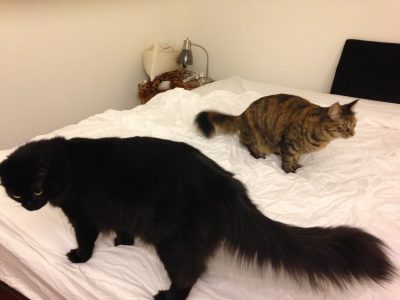The soon-to-arrive jacquard loom and the design freedom it will give me is a little bewildering. I’m used to working within the limitations of a shaft loom, which means I can’t do any sort of complex representative imagery. And I’m not all that interested in abstract designs. So for years and years, my focus has been on designing around the limitations of the loom. This means I can do a single musk ox, but I haven’t been able to do, say, a thundering herd of musk oxen rampaging through the Arctic wilderness.
Now I can. My highly constrained visual vocabulary is about to become nearly limitless. So now I’m finding myself at a loss: what would I say if I could say anything? I’ve been working around shaft limitations so long that I don’t have much practice in composition. I feel rather like a small-town girl let loose in the middle of New York City: There are so many amazing things to do and try, where does one even start?
So I’m thinking about taking Jane Dunnewold’s new class, Your Visual Language: Exploring Composition. She describes the class like this:
Contrast, relationship, symmetry, focal point, abstraction.
Terms you’d like to get to know better?
Then this is the right class for you. We’ll explore each of these concepts and a good deal more, through exercises done with cut paper, markers, and other simple design tools. Our goal is a clearer understanding of composition basics, with an emphasis on the articulation of personal visual language. Students will also have the option to share work in Open Studio, with other participants.
While I have considerable familiarity with the terms she mentioned, and I’ve had a college course in two-dimensional design already, I don’t have extensive experience practicing them in a textile context. I’m also intrigued by the “emphasis on the articulation of personal visual language”. I think that would be helpful for me as I explore this new world of creative freedom.
The timing of the class either couldn’t be better, or couldn’t be worse, depending on how you look at it. It runs for six weeks starting June 15, which means it will finish up just as the jacquard loom arrives. Hooray! But that is also the last six weeks before the book goes to the publisher. Boo. So it really depends on where I am with the book.
Nonetheless, I think I will sign up for the class. I’m not sure when or if it will be offered again, and if the book work becomes too intense, I can drop out. But I don’t think I’ll have to: the book is basically done at this point, so most of the work in the next four months is going to be getting photos, bios, etc. from artists, doing minor tweaks, and thinking about marketing opportunities. Plenty to be done, but not nearly as brain-draining as writing and editing the main text.
Meanwhile, what have I been up to? Catching up at work (where things have gone delightfully smoothly in my absence) and constructing a monster set of drafts. I wanted to see if I could weave matelassé and brocaded figured velvet with a stitched double-weave backing layer on the same warp. It turns out I can. I spent three days constructing the two drafts, which I’m not going to share because the drawdown looks like a confused mess. I have three warp systems and three wefts in both drafts, and the double weave structure adds another layer of complexity. I’m going to try simulating the fabric in ArahWeave later today, and if that works out, I’ll post a photo of the simulation.
Next task is to do better designs. I used very simple examples (velvet squares, matelasse circles) to figure out the construction of each structure. Now that I know how to do it, I can come back with more complex designs. It will still be a challenge to construct each draft, but hopefully easier the second time around. I am thinking I may write an article for Complex Weavers Journal on my construction algorithm, partly so I have a record of it myself, but also because it might be useful to others.
And, for those who have been patient with the photo-less-ness of the rest of this post, here’s a pic of a weekly household ritual: trying to change the sheets with two cats harassing, I mean helping, us. (Tigress in particular loves pouncing on the sheets as they move around. You can see her gearing up for a pounce in the photo…)

